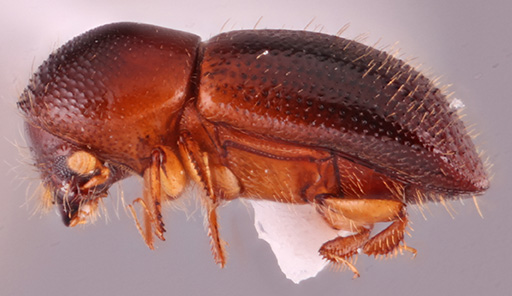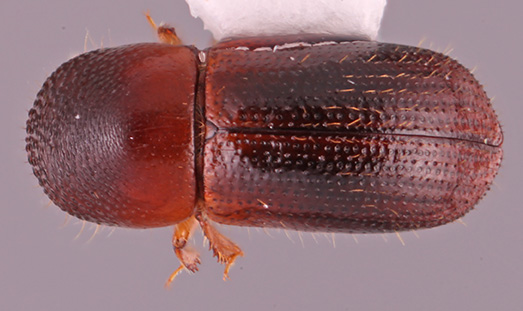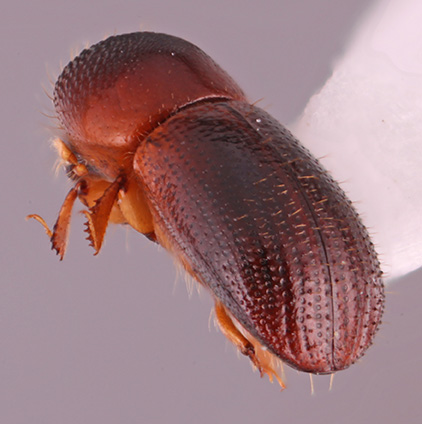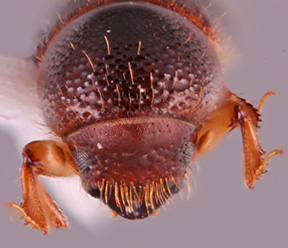Euwallacea andamanensis
|
Euwallacea andamanensis lateral; S.M. Smith |
|
Euwallacea andamanensis dorsal; S.M. Smith |
|
Euwallacea andamanensis declivity; S.M. Smith |
|
Euwallacea andamanensis frontal; S.M. Smith |
Taxonomic history
Xyleborus andamanensis Blandford, 1896b: 222.
Euwallacea andamanensis (Blandford): Wood, 1989: 172.
Synonyms
Xyleborus noxius Sampson, 1913: 445. Wood and Bright 1992: 686.
Xyleborus siobanus Eggers, 1923: 186. Schedl 1958c: 150.
Xyleborus burmanicus Beeson, 1930: 210. Schedl 1970b: 224.
Xyleborus intextus Beeson, 1930: 211. Wood 1989: 172.
Xyleborus senchalensis Beeson, 1930: 212. Wood 1989: 172.
Xyleborus granulipennis Eggers, 1930: 194. Wood 1989: 172.
Xyleborus talumalai Browne, 1966: 248. Hulcr and Cognato 2013: 90.
Diagnosis
2.8−3.4 mm long (mean = 3.12 mm; n = 5); 2.5−2.91 times as long as wide. This species is distinguished by its slender form; posterolateralposterolateral:
relating to end of the side part/portion
 margin of declivitydeclivity:
margin of declivitydeclivity:
downward slope of either the pronotum or elytra
 costate and granulategranulate:
costate and granulategranulate:
pertaining to a coarse, grainy surface texture
 , pronotumpronotum:
, pronotumpronotum:
the dorsal surface of the thorax
appearing subquadratesubquadrate:
almost quadrate, with oblique corners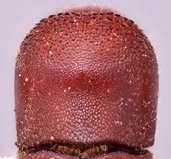 when viewed dorsally (type 3); and protibiaprotibia:
when viewed dorsally (type 3); and protibiaprotibia:
tibia of the first pair of legs
outer margin distinctly triangular bearing with five or fewer large acute denticles; strial punctures much larger on the declivitydeclivity:
downward slope of either the pronotum or elytra
 than on the discdisc:
than on the discdisc:
the flat central upper surface of any body part (e.g. pronotum and elytra) ; declivitydeclivity:
; declivitydeclivity:
downward slope of either the pronotum or elytra
 broadly rounded; declivitaldeclivital:
broadly rounded; declivitaldeclivital:
pertaining to the elytral declivity
surface often appearing opalescentopalescent:
iridescent, showing vaying colors
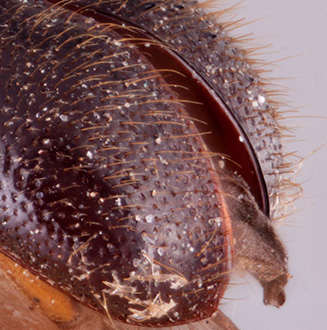 .
.
May be confused with
Euwallacea alastos, E. fornicatus species complex (E. fornicatior, E. fornicatus, E. kuroshio, E. perbrevis), E. geminus, E. malloti, E. neptis, E. semirudis, E. testudinatus, and E. velatus
Distribution
Bangladesh, Bhutan, Federated States of Micronesia, China (Hong Kong, Jiangxi, Yunnan), Indonesia (Buru I., Java, Mentawai Is., Sumatra), India (Andaman Is, Assam, Bihar, Madhya Pradesh, Maharashtra, Meghalaya, Tamil Nadu, West Bengal), Japan, Laos, West Malaysia, Myanmar, New Guinea, Thailand, Vietnam
Host plants
polyphagous (Beeson 1930Beeson 1930:
Beeson CFC. 1930. The biology of the genus Xyleborus , with more new species. Indian Forest Records 14: 209-272., Browne 1961bBrowne 1961b:
Browne FG. 1961b. The biology of Malayan Scolytidae and Platypodidae. Malayan Forest Records 22: 1-255.)
Remarks
Stouthamer et al. (2017) suggest that the synonymy of X. talumalai (Genbank number KU727039) with this species needs reinvestigation given the occurrence of the two species in two different clades with substantially different COI sequences. However, the findings of Stouthamer et al. are incorrect because they are based on a misidentified specimen of E. talumalai which is actually E. velatus.
This species is a species complex and is in need of revision (Cognato et al. 2020).
DNA data
Sequences available for COI and CAD.
COI: HM064084; MN619921; MN619922; MN619923; MN619924; MN619925; MN619926

